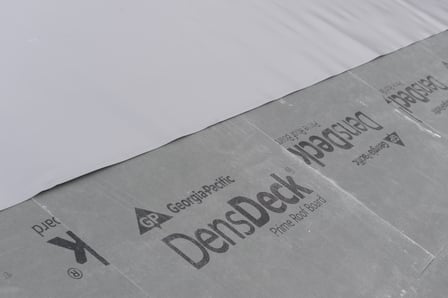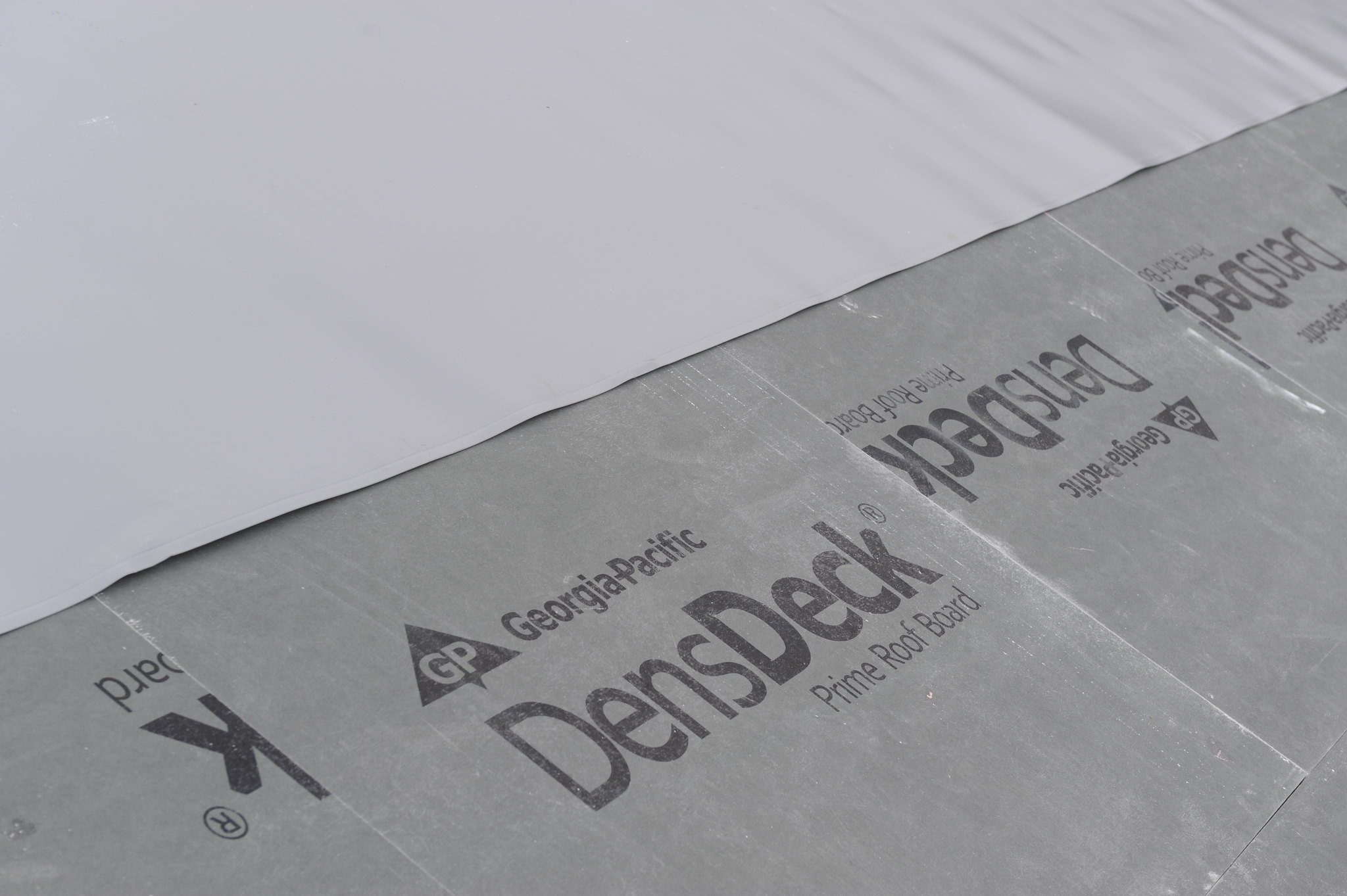Roofs provide aesthetic appeal, repel water, and reflect sunlight, but the insulation under your roof often benefits your building the most. Commercial roofing insulation is a protective barrier between the interior of the building and the environment outside. Properly installed insulation keeps building occupants comfortable and enhances structural integrity by protecting against moisture and other environmental concerns.
Experienced commercial roofing contractors work with architects and mechanical engineers to ensure that your building balances maximum efficiency and value. This blog will provide insights into everything you need to know about commercial roofing insulation, including ratings, types, and purposes of the various insulation applications.
How Is Commercial Roofing Insulation Rated?
Discussions about commercial roofing insulation center around an R-value. A material’s R-value represents how well it restricts heat flow. A laboratory determines the value by placing a one-inch piece of insulation between two plates and measuring the amount of heat that passes from one side to the other. The higher the R-value, the better a material is at slowing heat transfer.
Architects and mechanical engineers collaborate during a building’s design phase to determine the appropriate R-value for a commercial roof. Factors such as building purpose, building orientation to afternoon sunlight, and local building code requirements will influence the determination of a building’s thermal design.
Types of Commercial Roofing Insulation
Polyisocyanurate (Polyiso) and expanded polystyrene (EPS) are the most commonly used insulating materials.
Polyiso is a closed-cell foam with glass or foil facing. It is highly energy efficient, boasting a R-value of 5.6 per inch. In addition to the material’s high insulation value, it is also highly durable. The standard compressibility rating is 20 PSI, while 25 PSI is also available. Manufacturers can also provide a 60 PSI board to serve as a roof cover board and add additional rigidity to the roof system.
EPS is comparable to the styrofoam used in packaging but produced into sheets that can be made as thick as a job requires. The material’s 4.0 R-value shows it to be less heat resistant than polyiso. EPS is popular for installation because it is lightweight and easy to cut around roof penetrations or other features. Commercial roofers most commonly use EPS in “flute-fill” applications, where existing metal panel roofs are retrofitted with custom-cut EPS material and a new roof membrane covering.
Polyiso offers a distinct advantage in flame resistance, making it an industry standard for most types of buildings, especially hospitals, schools, or office spaces where it would be crucial to have ample time to evacuate in the event of a fire. EPS, on the other hand, is a highly flammable product. Using EPS in a commercial roof system often requires a fire-rated cover board and substrate board to sandwich the insulation between two fire-rated products.
Other less-commonly used insulation types include phenolic foam, polyurethane, and high-density extruded polystyrene (XPS).
Phenolic insulation consists of large foam rubber blocks with a metallic outer facing. This material was once very popular for its high R-value of 7.5. The material lost favor in the early 90s when it was determined to leach a corrosive chemical that damages metal roof decks and fasteners. Some concrete deck roofs may still have this material installed, but most specifiers have determined the potential concerns do not outweigh the value of the material.
Polyurethane insulation is a spray-on material that offers many benefits. The material’s 7.2 R-value is one of them. It is also highly fire and moisture-resistant, performs well over time, and is relatively easy to apply to odd-shaped roofs of many surface types due to its application method. Climate concerns during application are a significant inhibitor of polyurethane insulation’s popularity. A narrow temperature and humidity window make the material particularly difficult to work with in the Southeastern United States.
XPS is most typically used in wall applications, but there are specific instances, like a protected membrane roof, where the rigid styrofoam material could make sense. The material’s 5 R-value ranks the material in the middle of most cost/benefit analyses. Vulnerability to solvent-based adhesives and hot asphalt are two of the most common reasons why the material is not widely adopted.
 Roof insulation cover boards are another type of insulation. Most standard products are gypsum-cored boards, similar to interior drywall, but with a laminated facer on both sides for waterproofing. Gypsum cover boards offer exceptional fire ratings and a durable, walkable surface for your roof system. The material is generally available in ¼”, ½”, or ⅝” thicknesses. The facers can be custom-designed to receive an adhered roof system that bonds to the cover board.
Roof insulation cover boards are another type of insulation. Most standard products are gypsum-cored boards, similar to interior drywall, but with a laminated facer on both sides for waterproofing. Gypsum cover boards offer exceptional fire ratings and a durable, walkable surface for your roof system. The material is generally available in ¼”, ½”, or ⅝” thicknesses. The facers can be custom-designed to receive an adhered roof system that bonds to the cover board.
One crucial consideration when using an insulation board product is the “Thermal Break.” At joint locations in the insulation boards, heat can easily pass through this ⅛”-¼” crack. For this reason, it is recommended that insulation boards larger than 2.5” be installed in multiple layers, which allows the board joints to be staggered and eliminates the possibility of a thermal break.
What Type of Insulation Should You Use?
Determining the proper insulation for your building requires consideration of several factors, including the location, function, and design.
With new buildings, architects and engineers will work with skilled roofing contractors who understand local energy codes to define the specifications.
Energy calculations and fire rating requirements will typically drive the selection of insulation materials.
An office building in a warm climate with a glass facade exposed to the afternoon sun will require a higher overall R-value for peak comfort and energy efficiency. Institutional buildings like schools and hospitals typically have high foot traffic on the roof along with the previously mentioned fire concerns, so architects, engineers, and specifiers would factor that in during the design phase.
In existing buildings undergoing a roof replacement, it is crucial to have a commercial roofing contractor with extensive and current industry knowledge to help determine what is best for your structure. There are no energy-efficiency building codes explicitly relating to roof replacement. The only requirement is to maintain the building’s existing R-value.
Inexperienced roofing contractors may perform a complete tear-off with little regard to saving the insulation underneath, then put a new membrane on the roof deck and consider the job done. Decreasing a building’s efficiency has a ripple effect, including HVAC equipment working overtime to moderate temperature. Overtaxed air conditioning units produce excess condensation, which ultimately causes mold.
Register Roofing avoids this and other problems by evaluating the condition of your building’s current insulation before making recommendations. Our team will provide suggestions that will allow you to decide between maintaining your current efficiency level or perhaps upgrading your insulation to make your building greener and more energy-efficient. You can use these suggestions to perform a cost-benefit analysis on whether or not the utility savings over the roof's life justify the additional costs.
Register Roofing has been working with building owners, architects, and mechanical contractors to provide value-added insulation solutions, advice, and installations for over 40 years. If you are in the design phase of a building or preparing to replace your existing roof, leverage our experts to ensure your building is as comfortable, energy-efficient, and safe as possible.
